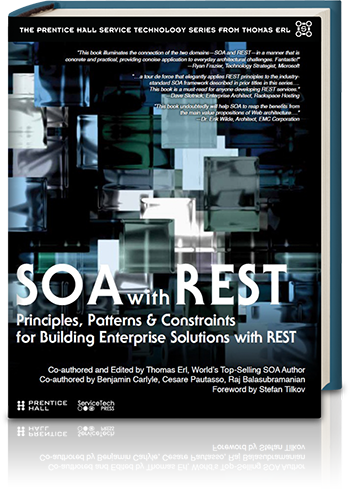This book begins with Chapters 1 and 2 providing introductory content and case study background information respectively. Provided here is a brief overview of subsequent chapters.
– Part I: Fundamentals
– Part II: RESTful Service-Orientation
– Part III: Service-Oriented Analysis and Design with REST
– Part IV: Service Composition with REST
– Part V: Supplemental
– Part VI: Appendices
Below are descriptions of individual parts and chapters:
Chapter 1: Introduction
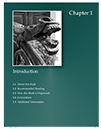 This chapter establishes the scope and structure of the book by providing an overview of the primary topic areas along with chapter descriptions and information regarding conventions and supplemental resources.
This chapter establishes the scope and structure of the book by providing an overview of the primary topic areas along with chapter descriptions and information regarding conventions and supplemental resources.
Chapter 2: Case Study Background
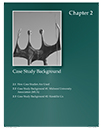 The chapters in this book contain numerous case study examples, all of which relate back to the case study background information established in this chapter. Appendix A concludes the case study storylines with a brief summary.
The chapters in this book contain numerous case study examples, all of which relate back to the case study background information established in this chapter. Appendix A concludes the case study storylines with a brief summary.
Part I: Fundamentals
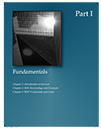
Chapter 3: Introduction to Services
Chapter 4: SOA Terminology and Concepts
Chapter 5: REST Constraints and Goals
Chapter 3: Introduction to Services
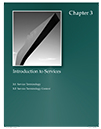
Service-related terminology and concepts can differ in relation to REST and SOA. This chapter provides a gentle introduction to services and includes clarifications necessary to avoid confusion in subsequent chapters.
Chapter 4: SOA Terminology and Concepts
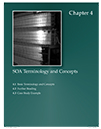 This chapter contains an overview of key terms and concepts associated with SOA, service-orientation, and related topic areas, such as service composition.
This chapter contains an overview of key terms and concepts associated with SOA, service-orientation, and related topic areas, such as service composition.
Chapter 5: REST Constraints and Goals
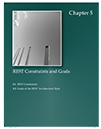 This chapter provides a brief overview of REST constraints and architectural design goals. For those of you already familiar with REST, be sure to at least read through the Interface constraint description to understand how this book uses the term “Uniform Contract” for this constraint instead.
This chapter provides a brief overview of REST constraints and architectural design goals. For those of you already familiar with REST, be sure to at least read through the Interface constraint description to understand how this book uses the term “Uniform Contract” for this constraint instead.
Part II: RESTful Service-Orientation
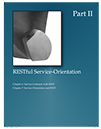
Chapter 6: Service Contracts with REST
Chapter 7: Service-Orientation with REST
Chapter 6: Service Contracts with REST
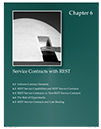 Building upon Chapters 3, 4, and 5, this chapter explores the fundamentals of REST service contracts and compares their characteristics and usage to non-REST variations. Also introduced is a distinct diagram symbol notation used to represent REST service contracts and service capabilities.
Building upon Chapters 3, 4, and 5, this chapter explores the fundamentals of REST service contracts and compares their characteristics and usage to non-REST variations. Also introduced is a distinct diagram symbol notation used to represent REST service contracts and service capabilities.
Chapter 7: Service-Orientation with REST
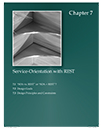
This chapter includes sections that map service-orientation design principles to REST constraints and architectural properties, and then further explores how REST can impact the goals of service-oriented computing.
Part III: Service-Oriented Analysis and Design with REST
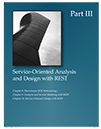
Chapter 8: Mainstream SOA Methodology
Chapter 9: Analysis and Service Modeling with REST
Chapter 10: Service-Oriented Design with REST
Chapter 8: Mainstream SOA Methodology
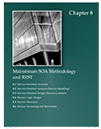 A brief introduction to the SOA project delivery phases is provided, along with content relating key stages to REST.
A brief introduction to the SOA project delivery phases is provided, along with content relating key stages to REST.
Chapter 9: Analysis and Service Modeling with REST
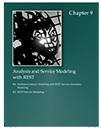
The complete service-oriented analysis process is explored, with case study examples and augmented for the modeling of REST-based service candidates, service capability candidates, and service composition candidates.
Chapter 10: Service-Oriented Design with REST
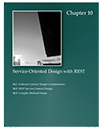
A varied collection of design-related topics is provided in this chapter to provide guidance for the creation of custom REST-based service contracts.
Part IV: Service Composition with REST
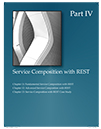
Chapter 11: Fundamental Service Composition with REST
Chapter 12: Advanced Service Composition with REST
Chapter 13: Service Composition with REST Case Study
Chapter 11: Fundamental Service Composition with REST
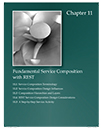 The unique design considerations that come with building service compositions comprised of REST services are addressed by a set of topics that tackle areas such as service models, service layers, and idempotency. The chapter concludes with a step-by-step sample scenario.
The unique design considerations that come with building service compositions comprised of REST services are addressed by a set of topics that tackle areas such as service models, service layers, and idempotency. The chapter concludes with a step-by-step sample scenario.
Chapter 12: Advanced Service Composition with REST
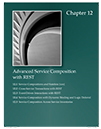 Some of the more challenging areas of REST-based service composition are covered in this dense chapter, including cross-service transactions, event-driven messaging, dynamic binding, and cross-service inventory interactions. A recurring theme throughout this chapter is compliance issues with the Stateless {xxx} constraint.
Some of the more challenging areas of REST-based service composition are covered in this dense chapter, including cross-service transactions, event-driven messaging, dynamic binding, and cross-service inventory interactions. A recurring theme throughout this chapter is compliance issues with the Stateless {xxx} constraint.
Chapter 13: Service Composition with REST Case Study
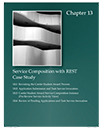 The services modeled and designed in the case study examples from Chapters 9 and 10 are now aggregated into a REST-based service composition architecture. This in-depth case study steps through two runtime scenarios and maps automated actions to original business process steps.
The services modeled and designed in the case study examples from Chapters 9 and 10 are now aggregated into a REST-based service composition architecture. This in-depth case study steps through two runtime scenarios and maps automated actions to original business process steps.
Part V: Supplemental
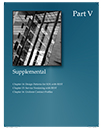
Chapter 14: Design Patterns for SOA with REST
Chapter 15: Service Versioning with REST
Chapter 16: Uniform Contract Profiles
Chapter 14: Design Patterns for SOA with REST
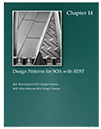 This important chapter provides plain English descriptions of the seven new REST-inspired SOA design patterns that have been added to the SOA design patterns catalog. Each of the explained patterns is officially represented via a profile in Appendix E.
This important chapter provides plain English descriptions of the seven new REST-inspired SOA design patterns that have been added to the SOA design patterns catalog. Each of the explained patterns is officially represented via a profile in Appendix E.
Chapter 15: Service Versioning with REST
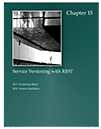 This chapter uses some basic versioning content from the series title Web Service Contract Design & Versioning for SOA and supplements it with REST service versioning topics and examples.
This chapter uses some basic versioning content from the series title Web Service Contract Design & Versioning for SOA and supplements it with REST service versioning topics and examples.
Chapter 16: Uniform Contract Profiles
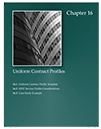 The uniform contract profile template is introduced, along with content describing a variation of the established service profile augmented to document REST service characteristics. The chapter concludes with a case study example in which a sample uniform contract profile is documented.
The uniform contract profile template is introduced, along with content describing a variation of the established service profile augmented to document REST service characteristics. The chapter concludes with a case study example in which a sample uniform contract profile is documented.
Part VI: Appendices
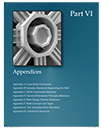 The remaining appendices conclude this book with further supporting content.
The remaining appendices conclude this book with further supporting content.
Appendix A: Case Study Conclusion
Appendix B: Industry Standards Supporting the Web
Appendix C: REST Constraints Reference
Appendix D: Service-Orientation Principles Reference
Appendix E: SOA Design Patterns Reference
Appendix F: State Concepts and Types
Appendix G: The Annotated SOA Manifesto
Appendix H: Additional Resources
Appendix A: Case Study Conclusion
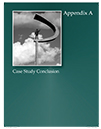
This appendix provides a breif conclusion of the case study storyline.
Appendix B: Industry Standards Supporting the Web
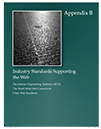
An overview of industry standards organizations and published specifications relevant to REST are provided in this appendix.
Appendix C: REST Constraints Reference
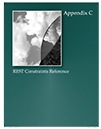
This appendix provides the profile tables for the REST design constraints referenced in this book.
Appendix D: Service-Orientation Principles Reference
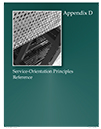
This appendix provides the profile tables (originally from SOA Principles of Service Design) for the service-orientation design principles referenced in this book.
Appendix E: SOA Design Patterns Reference
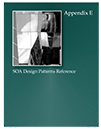 This appendix provides the profile tables for the SOA design patterns referenced in this book, including 14 new REST-inspired design patterns.
This appendix provides the profile tables for the SOA design patterns referenced in this book, including 14 new REST-inspired design patterns.
Appendix F: State Concepts and Types
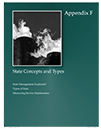 Fundamental terms and concepts originally introduced in Chapter 11 of SOA Principles of Service Design are provided primarily in support of content in Part IV of this book.
Fundamental terms and concepts originally introduced in Chapter 11 of SOA Principles of Service Design are provided primarily in support of content in Part IV of this book.
Appendix G: The Annotated SOA Manifesto
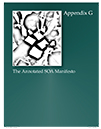 This appendix provides the annotated version of the SOA Manifesto declaration, which is also published at www.soa-manifesto.com.
This appendix provides the annotated version of the SOA Manifesto declaration, which is also published at www.soa-manifesto.com.
Appendix H: Additional Resources
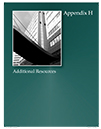 A list of relevant Web sites and supplementary resources is provided in this final appendix, including a bibliography of additional publications.
A list of relevant Web sites and supplementary resources is provided in this final appendix, including a bibliography of additional publications.


